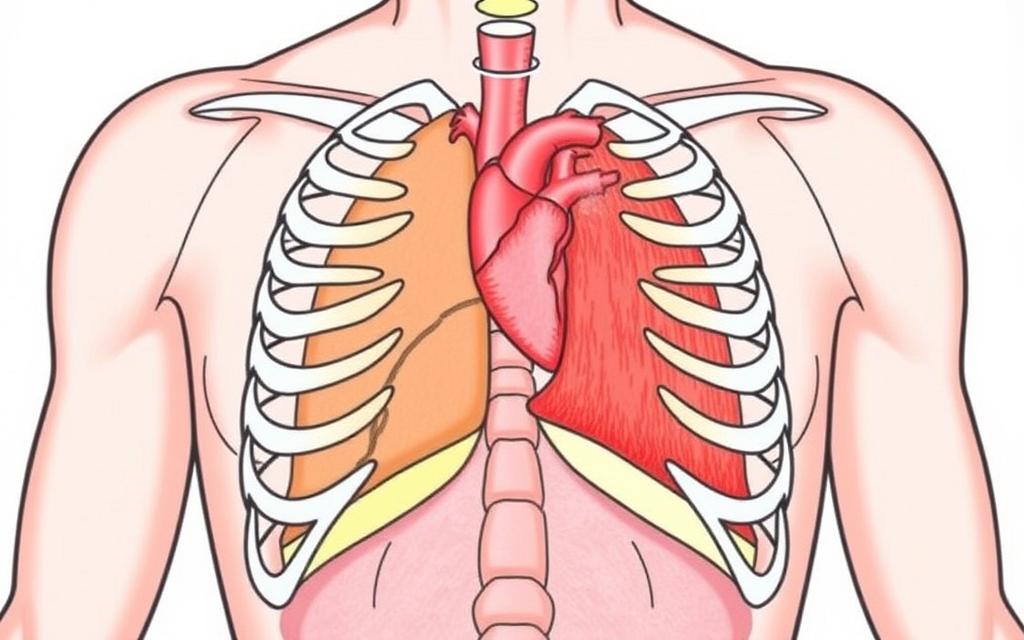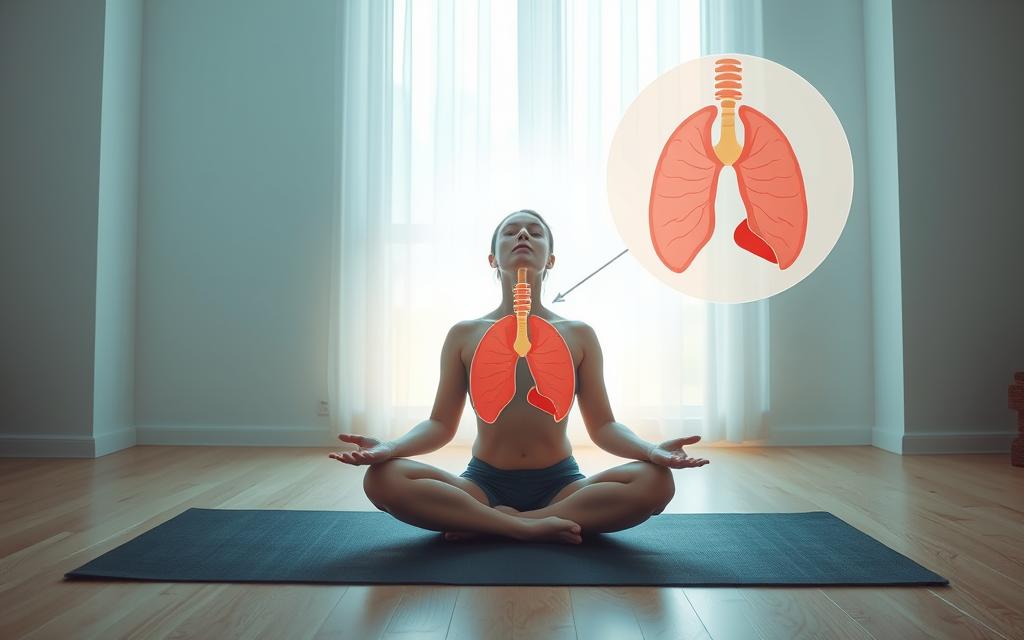Dealing with daily stress can be tough. But, I’ve found that breathing can calm the mind and body. Diaphragmatic breathing, or belly breathing, has changed my life. It’s a simple yet powerful way to find peace in busy times.
Diaphragmatic breathing uses the diaphragm to improve breathing. This muscle at the lungs’ base makes breathing easier. It strengthens the diaphragm and lowers breathing effort.
This technique also reduces stress and improves muscle function. It increases blood oxygen and lowers blood pressure and heart rate. It’s great for those with breathing or digestive issues, or anyone looking to relax.
Understanding the Diaphragm and Its Role in Breathing
The diaphragm is a key muscle for breathing. It’s located at the lungs’ base and is dome-shaped. It’s vital for the respiratory system.
When you inhale, the diaphragm flattens. This pulls air into the lungs and expands the chest. As you exhale, it relaxes, letting the lungs deflate and air out.
Anatomy of the Diaphragm
The diaphragm is a thin, dome-shaped muscle. It separates the chest from the belly. It connects to the ribs, spine, and sternum.
How the Diaphragm Functions During Breathing
When you inhale, the diaphragm contracts and flattens. This creates negative pressure in the chest. The lungs expand, drawing in air.
When exhaling, the diaphragm relaxes. The lungs deflate, pushing air out.
Natural Breathing Patterns
Optimal breathing uses the diaphragm fully. But, as we age, many start breathing with their chest more. This is called chest breathing.
Belly breathing, or diaphragmatic breathing, uses the diaphragm fully. It improves lung function and oxygen exchange.

“Proper diaphragmatic breathing can have a profound impact on your respiratory system, lung capacity, and overall physical and mental well-being.”
What Makes Diaphragmatic Breathing Different from Regular Breathing
Diaphragmatic breathing, also known as conscious breathing or deep breathing, is different from regular breathing. It focuses on using the diaphragm, a muscle at the base of the lungs. This is unlike regular breathing, which mainly uses the chest.
When you breathe diaphragmatically, you aim to make your stomach expand, not your chest. This leads to deeper, more effective breaths. It uses the lungs’ full capacity, improving respiratory efficiency.
As you breathe in, your diaphragm goes down, making your stomach go out. When you breathe out, your diaphragm relaxes, and your stomach goes back in. This way, you breathe more deeply and efficiently.
This breath control method triggers the body’s relaxation response. It’s different from the shallow, chest-based breathing techniques linked to stress and anxiety. By using your diaphragm, you breathe more consciously and improve your lung function.
“Diaphragmatic breathing is a powerful tool for reducing stress, improving lung function, and promoting overall well-being.”
Adding diaphragmatic breathing to your daily routine can bring many benefits. It’s great for improving your respiratory health and finding balance in life.

Health Benefits of Diaphragmatic Breathing
Diaphragmatic breathing, also known as belly breathing, offers many benefits. It helps your body and mind feel better. This technique focuses on using your diaphragm, which can greatly improve your health.
Physical Benefits
Diaphragmatic breathing can lower your heart rate and blood pressure. It also improves blood oxygenation and cardiovascular health. Plus, it strengthens your core, leading to better posture and less back and neck pain.
Mental and Emotional Benefits
This breathing method can lower stress hormone levels, helping you relax. It boosts concentration, energy, and motivation. It also helps with anxiety and depression symptoms.
Impact on Stress Levels
Diaphragmatic breathing activates the parasympathetic nervous system. This helps your body relax, reducing stress symptoms. It brings a sense of calm.
Adding diaphragmatic breathing to your daily life offers many benefits. It improves cardiovascular health and blood oxygenation. It also reduces stress and anxiety. It’s a simple yet effective way to boost your well-being.

“Diaphragmatic breathing has the potential to lower heart rate and blood pressure, while also improving core muscle stability and respiratory function.”
Getting Started with Diaphragmatic Breathing Exercises
Starting breathing exercises is a great way to relax and manage stress. Diaphragmatic breathing, or belly breathing, is easy and very helpful.
To begin, find a comfy spot to lie down or sit. Put one hand on your chest and the other on your belly. Breathe in through your nose, letting your belly rise while your chest stays still. Then, breathe out slowly through your mouth, feeling your belly fall.
- Start with short sessions of 5-10 minutes, 3-4 times a day.
- As you get better, increase the time and how often you do it.
Diaphragmatic breathing lets more oxygen into your blood and lowers stress. Shallow chest breathing, often seen when stressed, limits lung use. This breathing exercise activates your calm system, lowering blood pressure and stress hormones.
“Diaphragmatic breathing can become automatic with time, serving as a stress management tool.”
With regular practice, breathing this way can become a natural part of your day. It’s a great way to handle life’s ups and downs. Just remember, start slow and be kind to yourself as you learn.

Basic Technique for Beginners: Lying Down Position
If you’re new to diaphragmatic breathing, start with the lying down position. It’s a great way to learn the right breathing form. You’ll feel the benefits of deep, abdominal breathing. Here’s how to begin.
Step-by-Step Instructions
- Lie down on a flat surface, like the floor or a yoga mat, with your knees bent and your head supported.
- Place one hand on your chest and the other just below your rib cage, on your abdomen.
- Breathe in slowly through your nose, letting your abdomen rise as you fill your lungs. Keep your chest still.
- As you exhale, tighten your stomach muscles and let your abdomen fall, pushing the air out.
- Repeat this, focusing on keeping your chest still and letting your diaphragm do the work.
Common Mistakes to Avoid
When practicing this breathing exercises, watch out for a few common mistakes. They can help you get the most out of your breathing practice:
- Avoid moving your chest instead of your abdomen. The focus should be on your diaphragm, not your upper body.
- Don’t breathe too quickly. Slow, deep breaths are key to effective relaxation techniques.
- Make sure you’re fully engaging your diaphragm. If you’re not feeling the movement in your abdomen, try adjusting your body position or focus.
With regular proper form, this lying down breathing exercises can become automatic and more effective over time. Be patient with yourself as you cultivate this valuable breathing practice.

Advanced Sitting Position Techniques
After learning the basics of diaphragmatic breathing lying down, it’s time to try sitting exercises. This method lets you do seated breathing exercises and advanced diaphragmatic breathing anywhere. It’s great for handling stress or pain.
Start by sitting comfortably with your knees bent and your shoulders, head, and neck relaxed. Put your hands on your belly, just like in the lying down position. Take deep breaths, letting your belly go out as you inhale and in as you exhale. Try to keep your chest still, focusing on breath control and filling your belly with air.
- With regular practice, you can eventually perform this technique with your eyes open, while walking, or even while driving (when it’s safe to do so).
- Incorporating seated breathing exercises into your daily routine can help you manage stress and improve your overall well-being.
“Diaphragmatic breathing is a powerful tool for reducing stress and improving overall health. By taking the time to practice this technique, even for a few minutes a day, you can experience significant benefits.”
Consistency is key to mastering advanced diaphragmatic breathing. The more you practice, the easier it gets. Use this chance to control your breath control and enjoy the many benefits it brings.
Medical Conditions That Benefit from Diaphragmatic Breathing
Diaphragmatic breathing, also known as belly breathing, is great for many health issues. It boosts breathing and helps other body systems too.
Respiratory Conditions
People with chronic obstructive pulmonary disease (COPD) or asthma find it helpful. It improves how well they breathe and their overall life quality. It also helps with breathing rate, volume, and time in COPD patients.
Digestive System Benefits
It’s also good for irritable bowel syndrome (IBS). It helps with pain, bloating, and bowel movements. Deep breathing massages the vagus nerve, helping digestion.
Mental Health Applications
Diaphragmatic breathing is also great for anxiety and depression. It calms the mind and lowers stress hormones. It also connects the body and mind, improving well-being.
This breathing method helps with many health issues, like chronic pain management and sleep problems. Adding it to your daily routine, with doctor’s help, can greatly improve your health.

Incorporating Deep Breathing into Daily Life
Adding diaphragmatic breathing to your daily routine can change your life. It’s a simple yet powerful practice. It can be done anywhere, offering a calm break in our busy lives.
Try to set aside 10-30 minutes for slow, deep breathing each day. You can do it when you wake up, before meals, or during breaks. This relaxation practice can lower your stress levels and boost your mindfulness. You can also use it whenever you feel stressed or uncomfortable.
Learning to breathe deeply is a journey, but it’s worth it. Begin with just a few deep breaths whenever you can. Even 2-3 minutes of mindful breathing can calm you down and help you focus.
“Deep breathing is like a reset button for your mind and body. It’s a simple and effective way to manage stress and cultivate greater inner peace.”
As you get better at it, try different breathing methods. You might like the Counted Breath Technique, Guided Visualization with Breath, or the 4-7-8 Breathing Technique. Apps like Focus Bear can also help you stick to your daily relaxation practice and breathing habits.

The most important thing is to find a method that feels natural and easy for you. With regular practice, deep breathing can become a key stress management tool. It can help you be more mindful and improve your well-being every day.
Tips for Maintaining Proper Form
To get the most out of diaphragmatic breathing, you need to keep your form right. It’s all about how you sit and breathe. This is key for breathing well and feeling good.
Body Positioning Guidelines
Make sure you’re comfy, whether lying down or sitting up. Keep your shoulders, neck, and chest relaxed. This lets your diaphragm move freely and your belly expand when you breathe in.
Breathing Pattern Recommendations
- Take slow, steady breaths, inhaling through your nose and exhaling through pursed lips.
- Try to breathe in for 4 seconds, hold for 2, and breathe out for 6.
- Imagine filling and emptying a balloon in your stomach to help keep your diaphragm engaged.
Practicing regularly will make your breathing better. Using the right breathing technique, posture, and breath control boosts your respiratory efficiency and health.
“Proper form is the foundation for unlocking the full benefits of diaphragmatic breathing. With consistent practice, it becomes a natural, effortless way to breathe.”
Progress Tracking and Practice Schedule
Starting a breathing exercise routine can change your life. It’s important to track your diaphragmatic breathing progress to reach your relaxation goals. Pay attention to how your body and mind feel after each session. Look for any signs of calmness, less stress, and relief from symptoms.
Start with short sessions of 5-10 minutes, three to four times a day. As you get better, you can do longer sessions more often. Set achievable goals, like practicing before big events or taking short breaks during the day. Keep an eye on how your breathing changes and how you feel overall.
Writing down your experiences in a journal can help you see how far you’ve come. It’s a great way to spot patterns, celebrate your wins, and tweak your routine as needed. Regular diaphragmatic breathing can greatly improve your health in many ways.
“Diaphragmatic breathing is a game-changer. I’ve noticed a significant reduction in my stress levels and improved sleep quality since I started practicing it regularly.”
- Make a regular breathing exercise routine, aiming for 3-4 sessions a day.
- Slowly increase your practice time, starting with 5-10 minutes and aiming for longer sessions.
- Keep an eye on your diaphragmatic breathing progress by noticing changes in your breathing, stress, and overall health.
- Set relaxation goals, like practicing before stressful events or taking short breaks during the day.
- Writing down your experiences in a journal can help you track your progress and celebrate your achievements.
Regular practice and tracking your breathing exercise routine will help you get the most out of diaphragmatic breathing. It will also help you keep up with your relaxation goals for a long time.
Combining Diaphragmatic Breathing with Other Wellness Practices
Using a holistic approach to health can make diaphragmatic breathing even more effective. Adding this breathing method to your wellness routine can lead to deeper relaxation, better focus, and stress control.
Try combining diaphragmatic breathing with yoga or meditation. Yoga connects breath with movement, helping you stay in the moment. Meditation, paired with this breathing, can make you feel calmer and clearer.
Before you exercise or have physical therapy, diaphragmatic breathing can help. It relaxes your body and activates your parasympathetic nervous system. This can improve your performance and lower injury risks.
To manage stress better, mix diaphragmatic breathing with other relaxation techniques. Progressive muscle relaxation and guided imagery can help with both physical and mental stress. This mix can boost your overall well-being.
“Integrating diaphragmatic breathing with these wellness practices can create a more holistic approach to your health and well-being.”
Experiment to find the best mix for you. By adding diaphragmatic breathing to your daily life, you can reach its full potential. This can lead to a more balanced and fulfilling life.
Troubleshooting Common Challenges
Adding diaphragmatic breathing to your daily life can bring many benefits. But, you might face some early hurdles. Don’t worry, with practice and patience, you can beat these challenges and get the hang of it.
Initial Difficulties
Starting with diaphragmatic breathing can be tough. You might feel dizzy, struggle to use your diaphragm, or notice pain. These are normal signs as your body gets used to the new way of breathing.
Solutions and Adaptations
- If you feel dizzy, breathe more slowly and take shallower breaths. This helps your body adjust to the deeper breathing.
- Having trouble feeling your diaphragm? Try standing with your hands behind your head. This keeps your chest still and helps you focus on your belly moving.
- If it’s hard to fully use your diaphragm, don’t push too hard. Just take slow, calm breaths and let your body get used to it.
Remember, breathing exercise problems and technique improvement are part of learning. With regular diaphragmatic breathing tips and patience, you’ll soon enjoy the many benefits of this stress-reducing tool.
“Relaxation strategies improve with regular practice, so persistence is key to overcoming initial obstacles.”
Conclusion
Diaphragmatic breathing is a simple yet powerful technique. It boosts physical and mental health. By using the diaphragm, people can breathe better, feel less stressed, and handle health issues.
Regular practice makes it a daily tool for managing stress and improving well-being. This technique is easy to learn and use every day.
Studies show diaphragmatic breathing exercises are good for the body and mind. They improve breathing, lower blood pressure, and boost mood. This makes it a key part of a healthy lifestyle.
It’s important to talk to doctors before starting, if you have health issues. This ensures you use it safely and effectively. By doing so, you can enjoy the many benefits of diaphragmatic breathing and live a better life.
